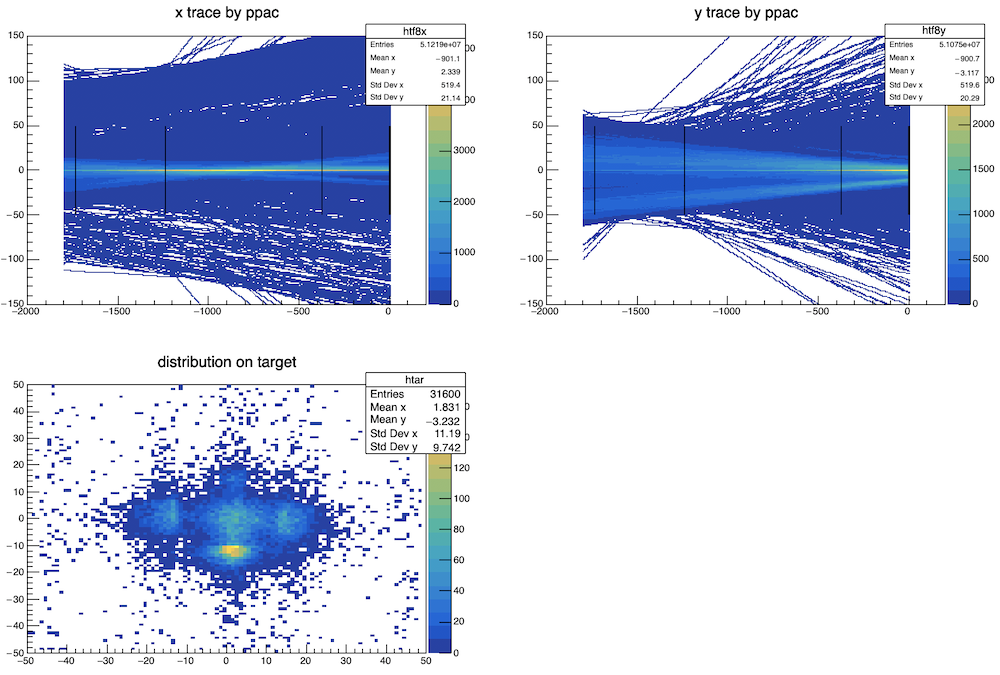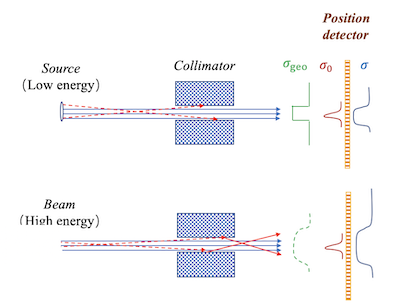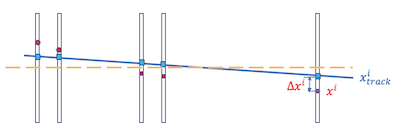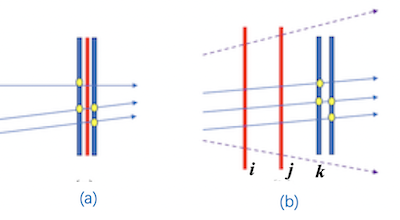2.2 PPAC 信号处理-II¶
1. Tracking¶
利用多个 PPAC 的位置 (x,y,z) 信息进行 traking 的原理如下图所示, 图中黑点和红点分别代表粒子实际入射位置以及探测器测量位置。由于 PPAC 的探测效率小于100%,对于每个入射粒子只有部分 PPAC 的 x 或 y 方向可给出位置信息。假设对于某一入射粒子,有两个以上(含两个)探测器给出x位置信息 (如图: 1Ax, 1Bx, 3x) 时,入射粒子的 x/y-z 径迹可由上述 x/y-z 点进行线性拟合得到。其他位置(z)的 (x,y) 坐标可利用上述线性方程内插或外推得到。图中黑点代表由线性方程计算得到的位置。
![]()
本实验中采用的重建策略为:¶
F8PPAC3有位置信号,且F8PPAC1和F8PPAC2中至少有一层PPAC有效。
F8PPAC3无位置信号,则
- a) F8PPAC1 和 F8PPAC2中的 3 层或 3 层以上的PPAC有位置信号。
- b) 当只有2层 PPAC 有信号,则要求两层PPAC分别来自 F8PPAC1 和 F8PPAC2。
束流径迹-利用所有PPAC的信息¶

2. PPAC 的位置分辨率¶
准直束刻度方法¶

- 通过准直孔将粒子准直,入射到探测器上。此时测得的位置分辨率$\sigma$与探测器本征位置分辨率$\sigma_0$的关系为
,其中$\sigma_{geo}$为准直孔引入的误差(图a)。
上述方法一般用放射源进行。实验表明 PPAC 探测器的位置分辨与入射粒子的种类以及能量相关,因此由放射源得到的分辨率用于评估探测器性能,但不能直接用在其他束流条件。
束流条件下,如果在探测器前放置准直孔,则由于束流在准直孔上产生散射(图b),使得$\sigma_{geo}$ 不仅与孔的几何条件有关,也与束流的条件相关,因此无法从测到的$\sigma^2$推知$\sigma^2_0$。
多探测器径迹测量方法(束流):¶

选择被全部PPAC(5层)测到的事件进行径迹重建,得到每个探测器的残差$\Delta x^i=x^i-x^i_{track}$的分布,其中$x^i$和$x^i_{track}$分别为测量和拟合得到的位置。径迹外推到靶所在的位置,得到靶点坐标 tx$_{track}$。
每个探测器的残差分布的宽度 $\sigma^i_{\Delta x}$ 是所有探测器本征分辨率的函数,即 $\sigma^i_{\Delta x} = \sigma^i_{\Delta x}(\sigma^0_0,\sigma^1_0...,\sigma^4_0)$。
探测器的本征分辨率可通过 Monte Carlo 模拟得到。具体做法如下:对于一组给定分辨率 $(\sigma^0_0,\sigma^1_0...,\sigma^4_0)$ ,每个探测器的位置 x$^{i}$ 由高斯抽样 Gauss$(x^i_{track},\sigma^i_0)$ 给出。拟合径迹得到每个探测器的拟合位置 x$^i_{track}$,以及残差 $\Delta$ x$^i$ = x$^i$-x$^i_{track}$ 分布,调节不同的分辨率, 使得模拟和实验的残差分布符合。这样就能间接算出每一层 PPAC 的位置分辨率。
- 为减少模拟中的参数,对于相同参数的气体探测器一般假设位置分辨率相同。

3. PPAC 探测效率¶

- 假设有$N$个粒子穿过探测器灵敏面积,探测器实际探测到的数目为$N_{det}$, 则探测效率$\epsilon$为
在本实验设置下,可以有很多方法求探测器的效率:
例1.ppac的阳极信号的计数作为分母,阴极计数作为分子(图a)。
例2.选择任意两组(i,j)探测器,拟合得到径迹, 记录径迹穿过探测器k灵敏面积的所有事件数目$N_{ij}$。记录在上述条件下探测器k具有正确位置信息的事件数目$N_{kij}$(图b)。
- 用上述做法可分别计算探测器的x,y,x-y的效率
ROOT文件中TTree的Branch:¶
$PPACF8[i][j]$ -Calibrated Data(位置已刻度好)
- z的位置为探测器平面的z方向坐标,通过位置测量给定。
- 已构建 x,y 信号(要求anode信号有效)。 不正确的位置信息:如超界、pileup等用 -999 表示,。
| Branch | PPAC | code |
|---|---|---|
| PPACF8[0][0] | PPAC 1 Layer A X (mm) | xx[0] |
| PPACF8[0][1] | PPAC 1 Layer A Y (mm) | yy[0] |
| PPACF8[0][2] | PPAC 1 Layer A Z for X-plan (mm) | xz[0] |
| PPACF8[0][3] | PPAC 1 Layer A Z for Y-plan (mm) | yz[0] |
| PPACF8[0][4] | PPAC 1 Layer A Anode time (ns) | |
| PPACF8[1][0] | PPAC 1 Layer B X (mm) | |
| PPACF8[1][1] | PPAC 1 Layer B Y (mm) | |
| PPACF8[1][2] | PPAC 1 Layer B Z for X-plan (mm) | |
| PPACF8[1][3] | PPAC 1 Layer B Z for Y-plan (mm) | |
| PPACF8[1][4] | PPAC 1 Layer B Anode time (ns) | |
| PPACF8[2][0-4] | PPAC 2 Layer A * | xx[1],yy[1],xz[1],yz[1] |
| PPACF8[3][0-4] | PPAC 2 Layer B * | xx2b,yy2b,xz2b,yz2b |
| PPACF8[4][0-4] | PPAC 3 * | xx[2],yy[2],xz[2],yz[2] |
示例代码¶
下面示例代码假设同时有1A,2A,3探测器给出x[0-2],y[0-2]的位置信息。2B探测器的信息用来求2Bx、2By、2Bx-y的探测效率。
- 三点拟合确定x-z平面内的束流径迹 x=fx(z):
(xx[0],xz[0]), (xx[1],xz[1]), (xx[2],xz[2])
- 三点拟合确定y-z平面内的束流径迹 y=fy(z):
(yy[0],yz[0]), (yy[1],yz[1]), (yy[2],yz[2])
- 残差(Residual):
dx[i]=xx[i]-fx(xz[i]), dy[i]=yy[i]-fy(yz[i]), i=0,1,2
- 实验测得的 F8PPAC2_B的 x-z,y-z坐标:
(xx2b[0],xz2b),(yy2b[0],yz2b)
- 拟合曲线得到的 F8PPAC2_B的 x-z,y-z坐标:
(xx2b[1],xz2b),(yy2b[1],yz2b)
anode2b: F8PPAC2_B的阳极信号
由拟合曲线外推的靶上坐标 (tx,ty)